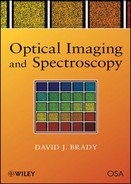ACKNOWLEDGMENTS
I began serious work on this text on the Fourth of July, 2004. I thank Rachael, Katherine, and Alexander for letting me write on the 4th (and occasionally on other holidays) and for their patience, love, and support over the 4 years absorbed by this project.
Draft forms of this text were used to teach courses at Duke University, the University of Illinois, and the University of Arizona. I thank the students enrolled in those courses for their patience with the text and problems and for helping to improve the material. I am also grateful to colleagues and students at the University of Minnesota, where I developed this text as a visitor to the Institute for Mathematics and Its Applications in Fall 2005.
The students and staff of the Duke Imaging and Spectroscopy Program (DISP) and its previous incarnation as the Illinois Interferometric Imaging Initiative were essential to the development of this text. Thanks to Alan Chen, Kent Hill, Scott Basinger, Ken Purchase, Junpeng Guo, Daniel Marks, Ron Stack, Remy Tumbar, Prasant Potluri, Yunhui Zheng, Evan Cull, John Burchette, Mohan Shankar, Bob Hao, Scott McCain, Scott Witt, Rick Tarka, Rick Morrison, George Barbastathis, Michal Balberg, Jose Jimenez, Matt Fetterman, Unnikrishnan Gopinathan, Santosh Narayankhedkar, Zhaochun Xu, Shawn Kraut, Ben Hamza, Michael Gehm, Yanquia Wang, Arnab Sinha, Michael Sullivan, Renu John, Nikos Pitsianis, Paul Vosburgh, Leah Goldsmith, and Bob Guenther. Current DISPers Andrew Portnoy, Christina Fernandez, Nan Zheng, Se Hoon Lim, Ashwin Wagadarikar, Yongan Tang and Nathan Hagen were particularly helpful in reviewing sections and exercises and tolerating their advisor's book obsession. I also remember that on January 1, 2001, DISP was just Steve Feller and I.
Demetri Psaltis introduced me to this subject, and Professor Psaltis and his students have been my closest friends and colleagues for many years. Mark Neifeld is central to this story and has starred in every role, including lab mate, colleague, competitor, collaborator, and friend. Ali Adibi, Ken Hsu, Mike Haney, and Kelvin Wagner have also been influential in the development of this text. Faculty colleagues at Illinois and Duke—particularly George Papen, Margery Osborne, Eric Michielssen, David Munson, Jim Coleman, Richard Blahut, Yoram Bresler, Pankaj Agrawal, Xiaobai Sun, Jungsang Kim, Rebecca Willett, Larry Carin, Daniel Gauthier, Joseph Izatt, Adam Wax, Curtis Taylor, Robert Clark, and Jeff Glass—have been an essential means of leading me from error and pointing me to opportunity. I also thank Kristina Johnson for luring me from my comfortable home in the Midwest to my more comfortable home in the Southeast.
Professor Dennis Healy of the University of Maryland and DARPA provided enormous inspiration and guidance for the concepts described in this text. I am also deeply grateful to Ravi Athale for philosophical guidance and for creating the DARPA MONTAGE program. Historically, imaging and spectroscopy are pursued by almost distinct communities. The link between these fields developed herein is due to Karen Petersen and her extraordinary initiative in starting the Advanced Biosensors Program at the National Institute on Alcoholism and Alcohol Abuse. The vison of Alan Craig at AFOSR and Jiri Jonas of the Beckman Institute in initially seeding my work on computational imaging and of Kent Miller of AFOSR in sustaining the vision over the years is also deeply appreciated.
Timothy Schulz has been generous and incredibly insightful in the development and execution of the Compressive Optical MONTAGE Photography Initiative. The fantastic COMPI team is too large to list comprehensively, but Alan Silver, Bob Gibbons, Mike Feldman, Bob Te Kolste, Joseph Mait, Dennis Prather, Michael Fiddy, Caihua Chen, Nicholas George, and Tom Suleski have been essential collaborators. Thanks also to the members of the computational imaging community who have given me hints, including W. Thomas Cathey, Rafael Piestun, Mark Christensen, Jim Leger, Alexander Sawchuck, Joseph Goodman, Jim Fienup, Richard Baraniuk, Kevin Kelly, Emmanuel Candes, Ronald Coifman, Jun Tanida, Joseph van der Gracht, Chuck Matson, Bob Plemmons, Sudhakar Prasad, and Shaya Fainman.
I am also grateful to the editorial staff of John Wiley & Sons for their efficient and professional assistance in the preparation of this text.
Of course, none of these individuals or institutions are reponsible for error, silliness, or other weaknessness in the text. I have written this book in the “editorial we,” partly so that I need not personally discover each equation and partly to remind myself that you and I are in this together, dear reader. I hope that in these pages we discover a common passion for optical sensing.
D. J. BRADY
Course materials, code used to generate figures, supplementary exercises, and other resources related to this text are available online at www.opticalimaging.org.
